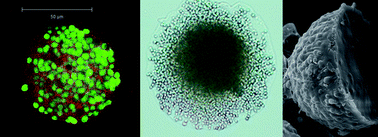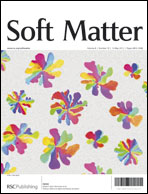Triggered cell release from shellac–cell composite microcapsules†
Abstract
We report the fabrication of novel shellac–cell composite microcapsules with programmed release of cells upon change of pH in a narrow range. The microcapsules were prepared from yeast cells as a model for probiotics combined with aqueous solution of ammonium shellac doped with a pH sensitive polyelectrolyte, like carboxymethyl cellulose or polyacrylic acid. The cell dispersions in aqueous ammonium shellac were spray-dried or spray co-precipitated to yield composite shellac–cell microcapsules in which the cells retained their viability even when treated with aqueous solutions of very low pH and subjected to mechanical stress. We demonstrate two types of triggered release of yeast cells from these microcapsules with pH trigger and cell growth trigger and evaluate the microcapsule disintegration rates. Depending on the type of the polyelectrolyte integrated in the shellac microcapsules they can be programmed to give very versatile responses ranging from slow cell release to


 Please wait while we load your content...
Please wait while we load your content...